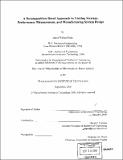| dc.contributor.advisor | David S. Cochran. | en_US |
| dc.contributor.author | Duda, James Wallace | en_US |
| dc.contributor.other | Massachusetts Institute of Technology. Dept. of Mechanical Engineering. | en_US |
| dc.date.accessioned | 2005-08-23T15:35:38Z | |
| dc.date.available | 2005-08-23T15:35:38Z | |
| dc.date.copyright | 2000 | en_US |
| dc.date.issued | 2000 | en_US |
| dc.identifier.uri | http://hdl.handle.net/1721.1/8819 | |
| dc.description | Thesis (Ph.D.)--Massachusetts Institute of Technology, Dept. of Mechanical Engineering, 2000. | en_US |
| dc.description | Includes bibliographical references (p. 235-239). | en_US |
| dc.description.abstract | The ability to understand the impact of lower-level design decisions on the achievement of higher-level strategic objectives is critical for the effective design of manufacturing systems. Furthermore, the development of a set of performance measures in alignment with these strategic objectives is necessary to ensure that ongoing design improvement activities result in better manufacturing system performance with respect to the goals of the firm. This thesis investigates how manufacturing systems can be designed to achieve the unique high-level strategic objectives of an organization and how performance measures can be derived to ensure that future system improvements support the firm's manufacturing strategy. A model of the manufacturing system design process is developed using the principles of systems engineering. This system design process begins with the identification and prioritization of relevant dimensions of manufacturing performance (cost, quality, delivery performance, etc.). Next, performance measures are developed concurrently with various possible models of system behavior and structure (i.e., design alternatives). Trade-offs among these design alternatives are examined, enabling designers to select the most appropriate feasible alternative and to identify opportunities for improvements. A structured process for trade-off analysis is developed to aid designers in identifying and analyzing the strengths and weaknesses of alternative system designs. An axiomatic design decomposition of a general set of functional requirements (FR's) and design parameters (DP's) for a manufacturing system is used to guide designers through this trade-off analysis as well as through the development of a preliminary set of performance measures. Matrices are formed to express the relationships between strategic objectives, FR's and DP's, and the design alternatives. Combination of these matrices results in the generation of a comparison matrix showing the relative strengths and weaknesses of each design alternative. A software tool is developed to assist designers in managing, visualizing, and communicating the information required for this trade-off analysis. Examples of the application of this process to the design of manufacturing systems at an automotive component supplier are reviewed. | en_US |
| dc.description.statementofresponsibility | by James Wallace Duda. | en_US |
| dc.format.extent | 239 p. | en_US |
| dc.format.extent | 25554630 bytes | |
| dc.format.extent | 25554384 bytes | |
| dc.format.mimetype | application/pdf | |
| dc.format.mimetype | application/pdf | |
| dc.language.iso | eng | en_US |
| dc.publisher | Massachusetts Institute of Technology | en_US |
| dc.rights | M.I.T. theses are protected by copyright. They may be viewed from this source for any purpose, but reproduction or distribution in any format is prohibited without written permission. See provided URL for inquiries about permission. | en_US |
| dc.rights.uri | http://dspace.mit.edu/handle/1721.1/7582 | |
| dc.subject | Mechanical Engineering. | en_US |
| dc.title | A decomposition-based approach to linking strategy, performance measurement, and manufacturing system design | en_US |
| dc.type | Thesis | en_US |
| dc.description.degree | Ph.D. | en_US |
| dc.contributor.department | Massachusetts Institute of Technology. Department of Mechanical Engineering | |
| dc.identifier.oclc | 48367436 | en_US |
